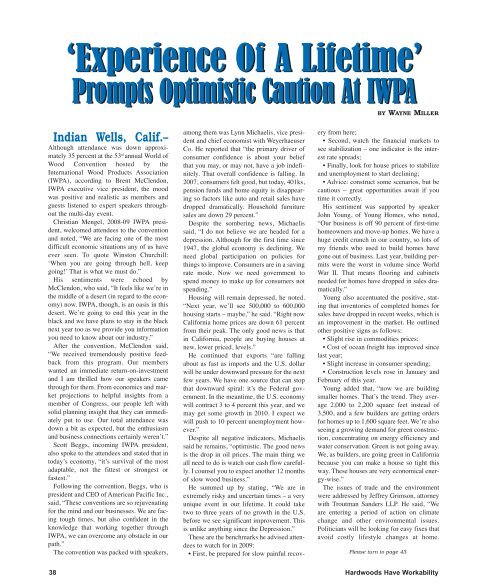LUMBER - Miller Publishing Corporation
LUMBER - Miller Publishing Corporation
LUMBER - Miller Publishing Corporation
You also want an ePaper? Increase the reach of your titles
YUMPU automatically turns print PDFs into web optimized ePapers that Google loves.
‘Experience Of A Lifetime’<br />
Prompts Optimistic Caution At IWPA<br />
Indian Wells, Calif.–<br />
Although attendance was down approximately<br />
35 percent at the 53 rd annual World of<br />
Wood Convention hosted by the<br />
International Wood Products Association<br />
(IWPA), according to Brent McClendon,<br />
IWPA executive vice president, the mood<br />
was positive and realistic as members and<br />
guests listened to expert speakers throughout<br />
the multi-day event.<br />
Christian Mengel, 2008-09 IWPA president,<br />
welcomed attendees to the convention<br />
and noted, “We are facing one of the most<br />
difficult economic situations any of us have<br />
ever seen. To quote Winston Churchill:<br />
‘When you are going through hell, keep<br />
going!’ That is what we must do.”<br />
His sentiments were echoed by<br />
McClendon, who said, “It feels like we’re in<br />
the middle of a desert (in regard to the economy)<br />
now. IWPA, though, is an oasis in this<br />
desert. We’re going to end this year in the<br />
black and we have plans to stay in the black<br />
next year too as we provide you information<br />
you need to know about our industry.”<br />
After the convention, McClendon said,<br />
“We received tremendously positive feedback<br />
from this program. Our members<br />
wanted an immediate return-on-investment<br />
and I am thrilled how our speakers came<br />
through for them. From economics and market<br />
projections to helpful insights from a<br />
member of Congress, our people left with<br />
solid planning insight that they can immediately<br />
put to use. Our total attendance was<br />
down a bit as expected, but the enthusiasm<br />
and business connections certainly weren’t.”<br />
Scott Beggs, incoming IWPA president,<br />
also spoke to the attendees and stated that in<br />
today’s economy, “it’s survival of the most<br />
adaptable, not the fittest or strongest or<br />
fastest.”<br />
Following the convention, Beggs, who is<br />
president and CEO of American Pacific Inc.,<br />
said, “These conventions are so rejuvenating<br />
for the mind and our businesses. We are facing<br />
tough times, but also confident in the<br />
knowledge that working together through<br />
IWPA, we can overcome any obstacle in our<br />
path.”<br />
The convention was packed with speakers,<br />
among them was Lynn Michaelis, vice president<br />
and chief economist with Weyerhaeuser<br />
Co. He reported that “the primary driver of<br />
consumer confidence is about your belief<br />
that you may, or may not, have a job indefinitely.<br />
That overall confidence is falling. In<br />
2007, consumers felt good, but today, 401ks,<br />
pension funds and home equity is disappearing<br />
so factors like auto and retail sales have<br />
dropped dramatically. Household furniture<br />
sales are down 29 percent.”<br />
Despite the sombering news, Michaelis<br />
said, “I do not believe we are headed for a<br />
depression. Although for the first time since<br />
1947, the global economy is declining. We<br />
need global participation on policies for<br />
things to improve. Consumers are in a saving<br />
rate mode. Now we need government to<br />
spend money to make up for consumers not<br />
spending.”<br />
Housing will remain depressed, he noted.<br />
“Next year, we’ll see 500,000 to 600,000<br />
housing starts – maybe,” he said. “Right now<br />
California home prices are down 61 percent<br />
from their peak. The only good news is that<br />
in California, people are buying houses at<br />
new, lower priced, levels.”<br />
He continued that exports “are falling<br />
about as fast as imports and the U.S. dollar<br />
will be under downward pressure for the next<br />
few years. We have one source that can stop<br />
that downward spiral: it’s the Federal government.<br />
In the meantime, the U.S. economy<br />
will contract 3 to 4 percent this year, and we<br />
may get some growth in 2010. I expect we<br />
will push to 10 percent unemployment however.”<br />
Despite all negative indicators, Michaelis<br />
said he remains, “optimistic. The good news<br />
is the drop in oil prices. The main thing we<br />
all need to do is watch our cash flow carefully.<br />
I counsel you to expect another 12 months<br />
of slow wood business.”<br />
He summed up by stating, “We are in<br />
extremely risky and uncertain times – a very<br />
unique event in our lifetime. It could take<br />
two to three years of no growth in the U.S.<br />
before we see significant improvement. This<br />
is unlike anything since the Depression.”<br />
These are the benchmarks he advised attendees<br />
to watch for in 2009:<br />
• First, be prepared for slow painful recov-<br />
BY WAYNE MILLER<br />
ery from here;<br />
• Second, watch the financial markets to<br />
see stabilization – one indicator is the interest<br />
rate spreads;<br />
• Finally, look for house prices to stabilize<br />
and unemployment to start declining;<br />
• Advice: construct some scenarios, but be<br />
cautious – great opportunities await if you<br />
time it correctly.<br />
His sentiment was supported by speaker<br />
John Young, of Young Homes, who noted,<br />
“Our business is off 90 percent of first-time<br />
homeowners and move-up homes. We have a<br />
huge credit crunch in our country, so lots of<br />
my friends who used to build homes have<br />
gone out of business. Last year, building permits<br />
were the worst in volume since World<br />
War II. That means flooring and cabinets<br />
needed for homes have dropped in sales dramatically.”<br />
Young also accentuated the positive, stating<br />
that inventories of completed homes for<br />
sales have dropped in recent weeks, which is<br />
an improvement in the market. He outlined<br />
other positive signs as follows:<br />
• Slight rise in commodities prices;<br />
• Cost of ocean freight has improved since<br />
last year;<br />
• Slight increase in consumer spending;<br />
• Construction levels rose in January and<br />
February of this year.<br />
Young added that, “now we are building<br />
smaller homes. That’s the trend. They average<br />
2,000 to 2,200 square feet instead of<br />
3,500, and a few builders are getting orders<br />
for homes up to 1,600 square feet. We’re also<br />
seeing a growing demand for green construction,<br />
concentrating on energy efficiency and<br />
water conservation. Green is not going away.<br />
We, as builders, are going green in California<br />
because you can make a house so tight this<br />
way. These houses are very economical energy-wise.”<br />
The issues of trade and the environment<br />
were addressed by Jeffrey Grimson, attorney<br />
with Troutman Sanders LLP. He said, “We<br />
are entering a period of action on climate<br />
change and other environmental issues.<br />
Politicians will be looking for easy fixes that<br />
avoid costly lifestyle changes at home.<br />
Please turn to page 43<br />
38 Hardwoods Have Workability

















